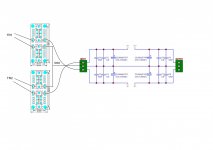Hi
I'm putting together a power supply for an A class aplifier. The power supply will have 600-700 W delivering two rails 45 V.
Not sure what diodes will use yet i have a choice 30CPQIOO 30CPQ150 60CPQ150 or MUR3020PT MUR3040PT MUR3060PT. I think i will go with shottky's
Here is a first draft, please chare some thoughts

I'm putting together a power supply for an A class aplifier. The power supply will have 600-700 W delivering two rails 45 V.
Not sure what diodes will use yet i have a choice 30CPQIOO 30CPQ150 60CPQ150 or MUR3020PT MUR3040PT MUR3060PT. I think i will go with shottky's
Here is a first draft, please chare some thoughts

Schottkys are fine in Class A if your PSRR is sufficiently high. I find them more problematic when the draw is less predictable.
I recommend you remove all the non electrolytics from the PSU.
Locate the local supply rail decoupling where the current demand changes, i.e. in the amplifier.
Locate the transformer snubber on the transformer output taps.
Locate the local supply rail decoupling where the current demand changes, i.e. in the amplifier.
Locate the transformer snubber on the transformer output taps.
Hey man ( idir ), if you dont really know about power supply , get there , and have a good read .
http://www.diyaudio.com/forums/powe...circuit-board-v3-illustrated-build-guide.html
you'll find all you need 😉
http://www.diyaudio.com/forums/powe...circuit-board-v3-illustrated-build-guide.html
you'll find all you need 😉
thank you, I'm reading a lot about rectifiers. What i see so far is that most of the folks will say that for 50 hz mains there is no need to use schottky's or fast diodes, just use cheap rectifiers 30 A 400V.
others will say that using faster solutions give subjective audible differences, that one cannot explain on paper.
i will continue to gather information until i'm clear on what type of rectifier to use.
So far I think I will use a capacitor board with 100 pieces 220 uF 63 V panasonic FR. CLC filtering, and non electrolytic capacitor to filter some other unwanted frequencies.
I think i might also use 2 monolithic bridges and then schottky diodes for testing purposes, co that i can check if i can hear any difference at all. will keep you posted
others will say that using faster solutions give subjective audible differences, that one cannot explain on paper.
i will continue to gather information until i'm clear on what type of rectifier to use.
So far I think I will use a capacitor board with 100 pieces 220 uF 63 V panasonic FR. CLC filtering, and non electrolytic capacitor to filter some other unwanted frequencies.
I think i might also use 2 monolithic bridges and then schottky diodes for testing purposes, co that i can check if i can hear any difference at all. will keep you posted
The biggest problem with schottkys and ultrafast rectifiers is their relatively poor non repetitive peak current capability. Even if the rectifier itself is infinitely robust, the bonding wires inside a TO247 will simply fuse somewhere not too far north of 100 amps with a single half sine pulse at 60 hz. Average capability is 75A and that's it. Charge up too many uf and you're done. Compare that to the 300 to 600 amp rating of your typical 25A standard recovery bridge. If you really want to use schottkys it may pay to find some old DO-5's because they will take the beating of cap charging duty. I doubt there are any still in production, though.
I did put together a rectifier bridge built with 4 30CPQ150 Shottky's. 12 pieces ELNA 4700 50 V for filtering that gives 56400 uF.
Sound on high frequencies is definitely smoother. diodes are fine, and cool with a small radiator.there is also more control over the bass.
Next step will be adding a coil between filtering capacitors for CLC filtering and maybe some non electrolytic capacitors as well. can you please recommend some tips here?
Sound on high frequencies is definitely smoother. diodes are fine, and cool with a small radiator.there is also more control over the bass.
Next step will be adding a coil between filtering capacitors for CLC filtering and maybe some non electrolytic capacitors as well. can you please recommend some tips here?
Shottky's are a good choice , I am running those :
http://www.mouser.com/ds/2/389/stps30sm120s-956580.pdf
they do a great job ;-)
if you wanna know what will be the result of your psu , download Psud2 , it helps a lot
PSUD2
.
http://www.mouser.com/ds/2/389/stps30sm120s-956580.pdf
they do a great job ;-)
if you wanna know what will be the result of your psu , download Psud2 , it helps a lot
PSUD2
.
I recommend you remove all the non electrolytics from the PSU.
Locate the local supply rail decoupling where the current demand changes, i.e. in the amplifier.
Locate the transformer snubber on the transformer output taps.
Andrew why should I remove all the "dry" capacitors? I use them to remove noise. 105's for low frequency and 102's for high frequency noise.
The ce on question is what should I do when I locate the snubber and rail?
Sent from my iPad using Tapatalk
- Status
- Not open for further replies.
- Home
- Amplifiers
- Power Supplies
- Power supply fo A class